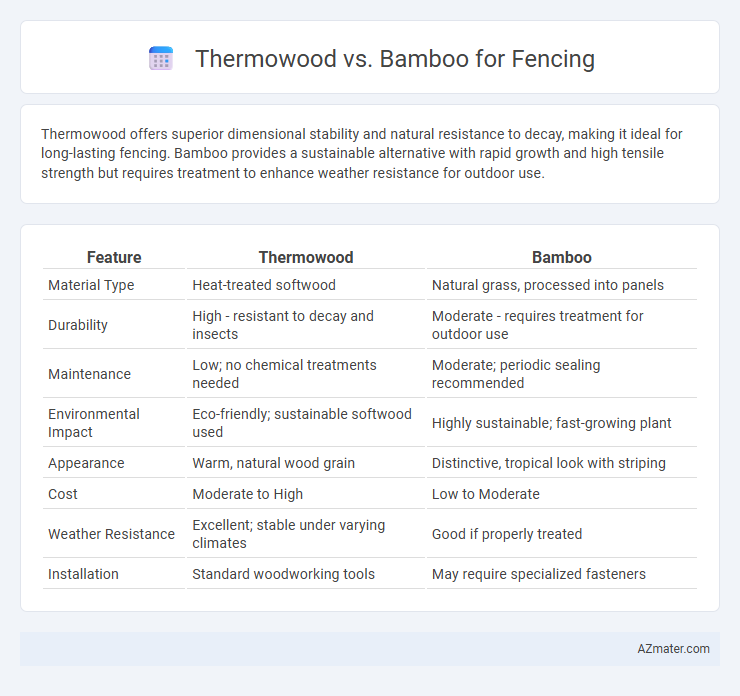Thermowood offers superior dimensional stability and natural resistance to decay, making it ideal for long-lasting fencing. Bamboo provides a sustainable alternative with rapid growth and high tensile strength but requires treatment to enhance weather resistance for outdoor use.
Table of Comparison
| Feature | Thermowood | Bamboo |
|---|---|---|
| Material Type | Heat-treated softwood | Natural grass, processed into panels |
| Durability | High - resistant to decay and insects | Moderate - requires treatment for outdoor use |
| Maintenance | Low; no chemical treatments needed | Moderate; periodic sealing recommended |
| Environmental Impact | Eco-friendly; sustainable softwood used | Highly sustainable; fast-growing plant |
| Appearance | Warm, natural wood grain | Distinctive, tropical look with striping |
| Cost | Moderate to High | Low to Moderate |
| Weather Resistance | Excellent; stable under varying climates | Good if properly treated |
| Installation | Standard woodworking tools | May require specialized fasteners |
Introduction to Thermowood and Bamboo Fencing
Thermowood is a heat-treated timber known for its enhanced durability, dimensional stability, and resistance to decay, making it an excellent choice for long-lasting fencing solutions. Bamboo fencing, derived from fast-growing grass species, offers a sustainable and eco-friendly alternative with natural strength and flexibility, ideal for decorative and privacy screens. Both materials provide unique aesthetic and environmental benefits, catering to various fencing needs and preferences.
Material Composition and Manufacturing Processes
Thermowood is produced by heat-treating softwood species like pine or spruce at temperatures between 180-230degC, altering its cellular structure to enhance durability, dimensional stability, and resistance to decay without chemicals. Bamboo fences utilize fast-growing, cellulose-rich bamboo stalks processed through mechanical or chemical treatments such as carbonization or heat treatment to improve durability and insect resistance while maintaining natural flexibility. The manufacturing of Thermowood relies on controlled thermal modification, whereas bamboo fencing involves harvesting, splitting, and treatment methods that maintain its tensile strength and eco-friendly characteristics.
Environmental Impact and Sustainability
Thermowood, produced by heat-treating softwoods such as pine or spruce, offers enhanced durability with minimal chemical additives, resulting in a lower environmental footprint compared to traditionally treated wood. Bamboo, a rapidly renewable grass, sequesters more carbon dioxide than most wood species and regenerates quickly after harvest, making it highly sustainable for fencing applications. Choosing between Thermowood and bamboo depends on balancing long-lasting performance with renewable resource availability and responsible sourcing practices.
Durability and Weather Resistance
Thermowood offers exceptional durability and weather resistance due to its heat-treated process, which enhances its stability and decay resistance, making it highly suitable for outdoor fencing in harsh climates. Bamboo, while strong and eco-friendly, is naturally more susceptible to moisture damage and requires regular treatment to maintain its durability and prevent rot or insect infestation. Comparing both, Thermowood's enhanced resilience to weather conditions typically results in a longer-lasting and low-maintenance fence solution.
Maintenance Requirements
Thermowood fences require minimal maintenance due to their enhanced durability and resistance to decay, often only needing occasional cleaning and oiling to maintain appearance. Bamboo fences, while eco-friendly and fast-growing, demand more frequent upkeep including sealing and protection from moisture to prevent rotting and insect damage. Choosing Thermowood ensures longer-lasting structural integrity with less effort, whereas Bamboo requires consistent maintenance to preserve its aesthetic and strength.
Aesthetic Appeal and Design Options
Thermowood offers a rich, warm color palette with natural wood grain patterns that enhance fence aesthetics through a variety of profiles and finishes, making it ideal for classic and modern designs. Bamboo provides a sleek, contemporary look with its fine texture and linear growth pattern, perfect for minimalist or eco-friendly fencing styles. Both materials support customization, but Thermowood allows more versatility in staining and shaping, while bamboo excels in creating uniform, sustainable designs.
Cost Comparison and Affordability
Thermowood fences typically cost between $15 to $25 per square foot, making them a moderately priced option known for durability and resistance to decay. Bamboo fencing generally ranges from $10 to $20 per square foot, offering a more affordable choice with a natural aesthetic but potentially less lifespan in harsh weather conditions. When comparing cost-effectiveness, bamboo provides initial savings, while Thermowood's longevity may reduce long-term replacement expenses.
Installation Ease and Methods
Thermowood offers straightforward installation due to its uniform density and stability, allowing for easy nailing, screwing, and minimal warping, which simplifies maintaining alignment. Bamboo fencing requires careful preparation because it is more prone to splitting and may demand pre-drilling holes and specialized fasteners to prevent damage during installation. Both materials benefit from using corrosion-resistant hardware to enhance durability in outdoor conditions, but Thermowood generally provides a more user-friendly installation process for DIY projects.
Longevity and Lifespan
Thermowood offers enhanced durability and resistance to decay due to its heat treatment process, extending its lifespan to approximately 20-30 years with minimal maintenance. Bamboo fences, while eco-friendly and fast-growing, generally last around 5-10 years and require regular treatment to prevent insect damage and weathering. Choosing Thermowood provides a longer-lasting fencing solution ideal for harsh climates, whereas bamboo suits cost-effective, short to medium-term applications.
Final Verdict: Choosing the Best Fence Material
Thermowood offers superior durability and resistance to weather, making it an excellent long-term fencing option with a natural wood aesthetic. Bamboo provides a sustainable, lightweight alternative with fast growth and eco-friendly benefits but may require more maintenance and protection against moisture. For a balance of strength, longevity, and environmental impact, Thermowood is often the preferred choice for high-performance fencing solutions.

Infographic: Thermowood vs Bamboo for Fence
 azmater.com
azmater.com